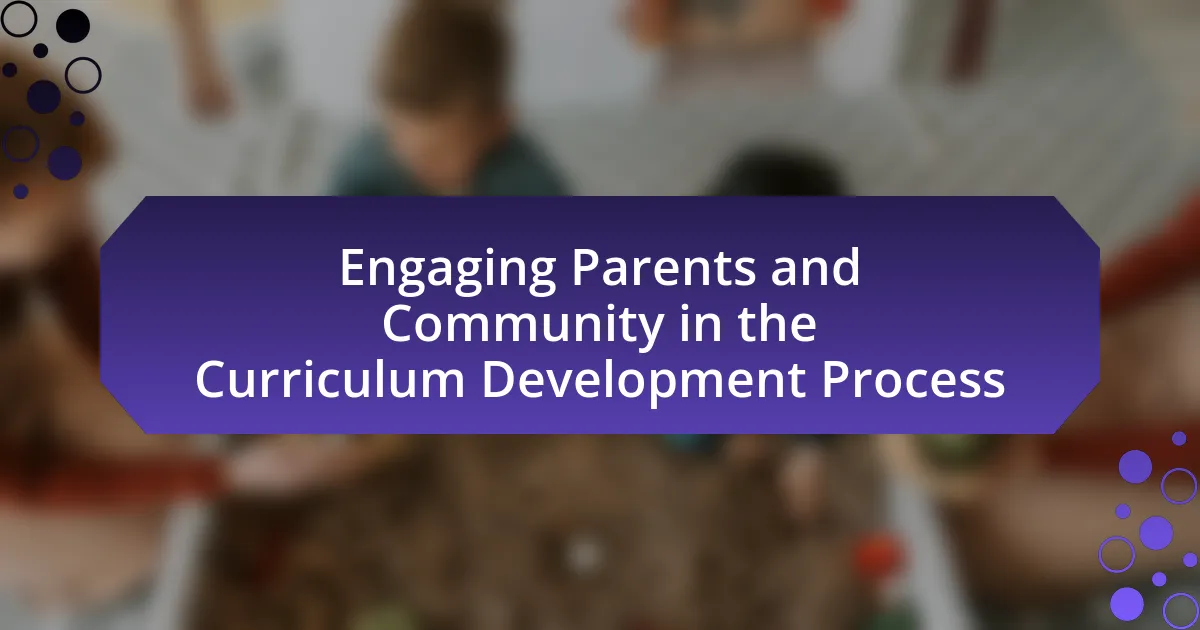Engaging parents and the community in the curriculum development process is essential for creating educational content that reflects local values and needs. This article outlines the importance of stakeholder involvement, highlighting how it enhances student learning outcomes and satisfaction with educational programs. Key principles of effective engagement, such as collaboration, transparency, and inclusivity, are discussed, along with strategies for fostering a collaborative environment. The article also addresses challenges in engagement, methods for communication, and best practices for incorporating feedback from parents and community members into curriculum development.

What is Engaging Parents and Community in the Curriculum Development Process?
Engaging parents and the community in the curriculum development process involves actively involving these stakeholders in shaping educational content and practices. This engagement ensures that the curriculum reflects the values, needs, and expectations of the community, fostering a collaborative environment that enhances student learning outcomes. Research indicates that schools that effectively engage parents and community members see improved student performance and increased satisfaction with educational programs, as highlighted in studies such as “The Impact of Family Engagement on Student Achievement” by the Harvard Family Research Project.
Why is it important to involve parents and the community in curriculum development?
Involving parents and the community in curriculum development is crucial because it enhances educational relevance and effectiveness. When parents and community members participate, they provide valuable insights into local needs, cultural contexts, and student interests, which can lead to a more tailored and impactful curriculum. Research indicates that schools with strong community engagement see improved student achievement and increased satisfaction among families. For instance, a study by the Harvard Family Research Project found that students whose parents are involved in their education perform better academically and have higher graduation rates. This evidence underscores the importance of collaboration between educators, parents, and the community in shaping a curriculum that meets the diverse needs of all students.
What roles do parents and community members play in this process?
Parents and community members play crucial roles in the curriculum development process by providing insights, resources, and support that reflect the needs and values of the community. Their involvement ensures that the curriculum is relevant and culturally responsive, which enhances student engagement and learning outcomes. Research indicates that when parents participate in educational decision-making, student achievement improves; for instance, a study by the Harvard Family Research Project found that students whose parents are involved in their education have higher grades and test scores. Community members contribute by sharing local knowledge and expertise, which can enrich the curriculum and make learning more applicable to real-world contexts.
How does their involvement impact student learning outcomes?
Their involvement significantly enhances student learning outcomes by fostering a supportive educational environment. Research indicates that when parents and community members actively participate in curriculum development, students demonstrate improved academic performance, higher attendance rates, and increased motivation. For instance, a study by the Harvard Family Research Project found that students whose parents are engaged in their education are 30% more likely to earn higher grades and test scores. This correlation underscores the importance of collaboration between educators and families in shaping effective learning experiences.
What are the key principles of effective engagement in curriculum development?
The key principles of effective engagement in curriculum development include collaboration, transparency, inclusivity, and responsiveness. Collaboration involves actively involving stakeholders, such as parents, teachers, and community members, in the decision-making process, ensuring diverse perspectives are considered. Transparency requires clear communication about goals, processes, and outcomes, fostering trust among participants. Inclusivity emphasizes the importance of engaging all relevant voices, particularly those from underrepresented groups, to create a curriculum that reflects the community’s needs. Responsiveness entails adapting the curriculum based on feedback and changing circumstances, ensuring it remains relevant and effective. These principles are supported by research indicating that stakeholder engagement leads to improved educational outcomes and community satisfaction.
How can schools foster a collaborative environment with parents and the community?
Schools can foster a collaborative environment with parents and the community by implementing regular communication channels, such as newsletters, meetings, and workshops. These initiatives encourage active participation and feedback from parents and community members, ensuring their voices are heard in the educational process. Research indicates that schools with strong family and community engagement see improved student outcomes, as highlighted in the study “A New Wave of Evidence: The Impact of School, Family, and Community Connections on Student Achievement” by the Southwest Educational Development Laboratory. This study shows that effective collaboration leads to higher student achievement and better school performance.
What strategies can be employed to ensure diverse voices are heard?
To ensure diverse voices are heard, educational institutions can implement strategies such as inclusive stakeholder meetings, targeted outreach, and the establishment of advisory committees. Inclusive stakeholder meetings allow for the participation of various community members, ensuring that different perspectives are represented. Targeted outreach involves actively seeking input from underrepresented groups, which can be achieved through surveys, focus groups, or community forums. Establishing advisory committees composed of diverse community representatives can provide ongoing feedback and guidance, fostering a culture of inclusivity. Research indicates that schools that engage diverse stakeholders in curriculum development see improved educational outcomes and community satisfaction, highlighting the effectiveness of these strategies.

How can schools effectively engage parents and the community?
Schools can effectively engage parents and the community by implementing regular communication channels, such as newsletters, meetings, and digital platforms. These methods foster transparency and keep parents informed about school activities and curriculum changes. Research indicates that schools with strong parent engagement see improved student outcomes; for instance, a study by the Harvard Family Research Project found that students whose parents are involved in their education have higher grades and test scores. Additionally, schools can create opportunities for parents to participate in decision-making processes, such as curriculum development committees, which enhances community investment in educational outcomes.
What methods can be used to communicate with parents and community members?
Effective methods to communicate with parents and community members include regular newsletters, social media updates, community meetings, and surveys. These methods facilitate ongoing dialogue and information sharing, ensuring that parents and community members are informed and engaged in the curriculum development process. For instance, newsletters can provide updates on curriculum changes and upcoming events, while social media platforms allow for real-time communication and feedback. Community meetings offer a space for direct interaction and discussion, and surveys can gather input on community needs and preferences, enhancing the relevance of the curriculum.
How can technology facilitate engagement in the curriculum development process?
Technology can facilitate engagement in the curriculum development process by providing platforms for collaboration and communication among educators, parents, and community members. Tools such as online surveys, discussion forums, and collaborative software enable stakeholders to share their insights and feedback efficiently. For instance, a study by the National Education Association found that schools using digital platforms for parent engagement reported a 30% increase in participation in curriculum discussions. This demonstrates that technology not only streamlines communication but also enhances the involvement of diverse voices in shaping educational content.
What are the best practices for organizing community meetings and workshops?
The best practices for organizing community meetings and workshops include clear objectives, effective communication, and inclusive participation. Establishing clear objectives ensures that the meeting has a focused purpose, which helps in guiding discussions and outcomes. Effective communication involves sharing information about the meeting’s agenda, goals, and logistics well in advance, allowing participants to prepare adequately. Inclusive participation means actively encouraging diverse community members to contribute, which can be achieved through outreach efforts and providing accessible meeting formats. Research indicates that inclusive practices lead to higher engagement levels, as seen in studies by the National Coalition for Dialogue & Deliberation, which highlight the importance of diverse voices in community decision-making processes.
How can feedback from parents and the community be incorporated into curriculum development?
Feedback from parents and the community can be incorporated into curriculum development through structured surveys, focus groups, and community forums. These methods allow educators to gather diverse perspectives and insights on educational needs and priorities. For instance, a study by the National Education Association found that schools that actively engage parents in curriculum discussions see improved student outcomes and satisfaction. By analyzing this feedback, curriculum developers can align educational content with community values and expectations, ensuring that the curriculum is relevant and effective.
What tools can be used to gather input from stakeholders?
Surveys and questionnaires are effective tools for gathering input from stakeholders. These tools allow for the collection of structured feedback from parents, community members, and educators regarding their perspectives on curriculum development. Research indicates that using surveys can yield quantitative data that is easily analyzed, while open-ended questions can provide qualitative insights. Additionally, focus groups facilitate in-depth discussions, enabling stakeholders to express their views in a collaborative environment. According to a study by the National Education Association, engaging stakeholders through these methods enhances the relevance and effectiveness of educational programs.
How can schools ensure that feedback is acted upon in a meaningful way?
Schools can ensure that feedback is acted upon in a meaningful way by establishing structured processes for collecting, analyzing, and implementing feedback from parents and the community. This involves creating regular opportunities for stakeholders to provide input, such as surveys, focus groups, and community meetings, which can lead to actionable insights. For instance, a study by the National School Boards Association found that schools that actively engage parents in feedback processes see a 20% increase in student achievement, demonstrating the effectiveness of incorporating community perspectives into curriculum development. By systematically reviewing feedback and integrating it into decision-making, schools can create a responsive educational environment that reflects the needs and expectations of the community.

What challenges might arise in engaging parents and the community?
Engaging parents and the community in the curriculum development process may face several challenges, including communication barriers, differing priorities, and lack of time. Communication barriers can arise from language differences or varying levels of understanding about educational processes, which can hinder effective collaboration. Differing priorities between educators and parents can lead to conflicts regarding curriculum content and objectives, as parents may have specific cultural or personal values they wish to see reflected. Additionally, many parents and community members may struggle to find the time to participate due to work commitments or other responsibilities, limiting their involvement in discussions and decision-making. These challenges can impede the successful engagement of parents and the community in shaping educational curricula.
What barriers exist that may hinder effective engagement?
Barriers that may hinder effective engagement include communication gaps, lack of time, and cultural differences. Communication gaps arise when information is not shared clearly or frequently, leading to misunderstandings and disengagement. Lack of time is a significant barrier, as parents and community members often have competing responsibilities that limit their availability to participate in engagement activities. Cultural differences can also impede engagement, as varying backgrounds may lead to differing expectations and interpretations of involvement in the curriculum development process. These barriers collectively reduce the likelihood of meaningful participation from parents and community members, ultimately affecting the success of curriculum initiatives.
How can schools address issues of accessibility and inclusivity?
Schools can address issues of accessibility and inclusivity by implementing universal design principles in their curriculum and facilities. This approach ensures that educational materials and environments are accessible to all students, regardless of their abilities or backgrounds. For instance, incorporating assistive technologies, such as screen readers and adaptive learning tools, can significantly enhance learning experiences for students with disabilities. Additionally, schools can provide training for staff on inclusive teaching practices, which has been shown to improve educational outcomes for diverse learners. Research indicates that inclusive education not only benefits students with disabilities but also fosters a more supportive and collaborative learning environment for all students.
What strategies can be implemented to overcome resistance from stakeholders?
To overcome resistance from stakeholders, effective communication and involvement strategies should be implemented. Engaging stakeholders early in the curriculum development process fosters a sense of ownership and reduces opposition. Research indicates that when stakeholders are actively involved, such as through workshops or feedback sessions, their concerns are addressed, leading to increased support for initiatives. For instance, a study by the Harvard Family Research Project highlights that inclusive practices in educational settings significantly enhance stakeholder buy-in and collaboration.
How can schools measure the success of their engagement efforts?
Schools can measure the success of their engagement efforts by analyzing participation rates in events and feedback from parents and community members. For instance, tracking attendance at workshops, meetings, and school events provides quantitative data on engagement levels. Additionally, surveys can be distributed to gather qualitative feedback on the effectiveness of communication and involvement strategies. Research indicates that schools with higher parent engagement see improved student outcomes, as evidenced by a study from the Harvard Family Research Project, which found that effective family engagement correlates with higher student achievement and better school performance.
What metrics can be used to evaluate the effectiveness of community involvement?
Metrics to evaluate the effectiveness of community involvement include participation rates, feedback surveys, and impact assessments. Participation rates measure the number of community members engaged in activities, indicating the level of interest and involvement. Feedback surveys collect qualitative and quantitative data on community perceptions and satisfaction, providing insights into the effectiveness of engagement strategies. Impact assessments evaluate the outcomes of community involvement on curriculum development, such as improvements in student performance or increased community support for educational initiatives. These metrics collectively provide a comprehensive view of how effectively the community is engaged in the curriculum development process.
How can schools adapt their strategies based on evaluation results?
Schools can adapt their strategies based on evaluation results by analyzing data to identify strengths and weaknesses in their curriculum and instructional methods. For instance, if evaluation results indicate that students are struggling in mathematics, schools can implement targeted interventions such as additional tutoring, revised lesson plans, or professional development for teachers focused on effective math instruction. Research shows that schools that utilize data-driven decision-making improve student outcomes; a study by the Institute of Education Sciences found that schools using data effectively saw a 10-20% increase in student performance. By continuously monitoring and adjusting strategies based on evaluation feedback, schools can enhance educational effectiveness and better engage parents and the community in the curriculum development process.
What are some practical tips for engaging parents and the community in curriculum development?
To effectively engage parents and the community in curriculum development, schools should implement regular communication channels, such as newsletters and community meetings, to gather input and feedback. Research indicates that schools with strong parent and community involvement see improved student outcomes, as highlighted in the study “The Impact of Family and Community Involvement on Student Achievement” by the Harvard Family Research Project. Additionally, creating advisory committees that include parents and community members can ensure diverse perspectives are considered in curriculum decisions. Engaging parents through workshops and informational sessions about curriculum goals fosters a collaborative environment, enhancing their investment in educational outcomes.
How can schools create a welcoming environment for parents and community members?
Schools can create a welcoming environment for parents and community members by fostering open communication and collaboration. Establishing regular forums, such as parent-teacher meetings and community workshops, allows for dialogue and input on school initiatives. Research indicates that schools with strong family engagement see improved student outcomes; for instance, a study by the Harvard Family Research Project found that effective family engagement strategies can lead to higher student achievement and better school attendance. Additionally, creating inclusive spaces, such as family resource centers, and providing multilingual resources can further enhance accessibility and comfort for diverse community members.
What ongoing practices can sustain engagement over time?
Ongoing practices that can sustain engagement over time include regular communication, collaborative decision-making, and continuous feedback mechanisms. Regular communication, such as newsletters or community meetings, keeps parents and community members informed and involved in the curriculum development process. Collaborative decision-making allows stakeholders to contribute their insights and preferences, fostering a sense of ownership and commitment. Continuous feedback mechanisms, such as surveys or focus groups, enable ongoing dialogue and adaptation based on community needs and responses. Research indicates that schools with strong parent and community engagement see improved student outcomes, highlighting the effectiveness of these practices in maintaining long-term involvement.



